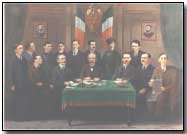The Irish Free State Constitution Act 1922 (Session 2) was an Act of the Parliament of the United Kingdom, passed in 1922 to confirm the Constitution of the Irish Free State, and to ratify the 1921 Anglo-Irish Treaty.
As originally enacted, the Irish Free State Constitution Act 1922 consisted of a preamble, five sections (three of which were very brief), and a schedule. The bill for the Act was introduced by the Prime Minister David Lloyd George into the Parliament of the United Kingdom in November 1922. The bill's third reading in the House of Commons was on 30 November.
The Preamble, like the preamble to the Act passed by the Provisional Parliament of the Free State, bases the Constitution on the Anglo-Irish Treaty of 6 December 1921. It recites that the Constitution shall be construed in reference to the Treaty and:
"if any provision of the said Constitution or of any amendment thereof or of any law made there under is in any respect repugnant to any of the provisions of the Scheduled Treaty [the Anglo-Irish Treaty], it shall, to the extent only of such repugnancy be absolutely void and inoperative and the Parliament and the Executive Council of the Irish Free State shall respectively pass such further legislation and do such other things as may be necessary to implement the Scheduled Treaty."
The first section of the Act declares the Constitution adopted by the Provisional Parliament to be the Constitution of the Irish Free State. Its adoption is to be effective not later than 6 December 1922 by Royal Proclamation and the Constitution will come into operation on the issue of such Royal Proclamation. Section 2 makes provision for certain taxation related matters.
The Constitution of the Irish Free State in the form in which it was passed by the Provisional Parliament forms the First Schedule of the Act. The Articles of Agreement for a treaty between Great Britain and Ireland form the Second Schedule.
The New York Times reported on the passing of the Act on 5 December 1922 as follows:
At 6 o’clock this evening an event of great historic interest and of international importance took place in the House of Lords. A few minutes before that hour the Irish Free State Constitution bills had passed the final stage in the House of Commons by formal acceptance of the Lords’ amendments. It was brought back, beribboned and sealed, by the Clerk of the Commons himself, and handed to the Clerk of the Parliament to receive the Royal assent. This was conferred, as usual, by the Royal Commission, the members of which were Lord Cave, Lord Novar and Lord Somerleyton.....King George will make a special journey from Sandringham tomorrow to hold a privy council in Buckingham Palace, at which he will sign a proclamation declaring the adoption of the Irish Constitution by the British and Irish Parliaments. The Constitution will come into operation immediately on the issue of the proclamation.
The New York Times also reported that in Parliament a group of Communists singing "The Red Flag" caused a minor disturbance as the formalities relating to the Act's passage were underway.
Article 12 of the Treaty [in law, Section 5 of the Irish Free State Constitution Act, 1922] accorded to Northern Ireland the right to secede from the new Free State and rejoin the United Kingdom, giving its parliament a month in which to decide; the so-called "Ulster Month".
On 7 December 1922, the day after the establishment of the Irish Free State, the Parliament of Northern Ireland addressed the King unanimously requesting its secession from Irish Free State. The King replied shortly thereafter to say that he had caused his Ministers and the Government of the Irish Free State to be informed that Northern Ireland was to do so. The address and its overall effect was known locally as the "Constitution Act".

No comments:
Post a Comment